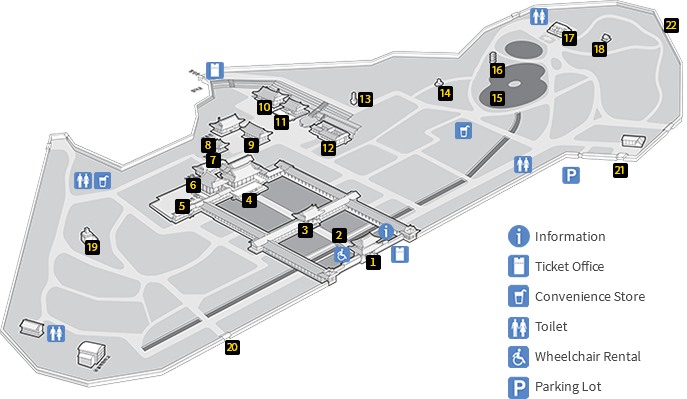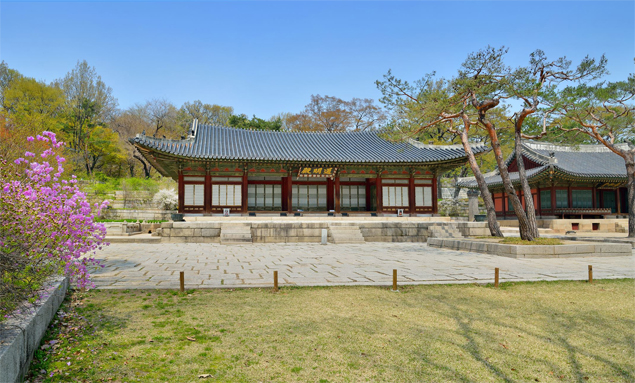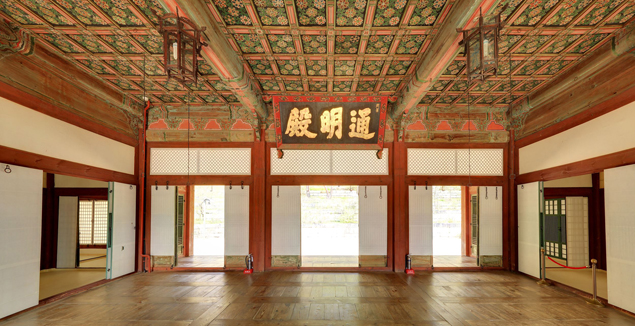Changgyeonggung Palace
- 1. Honghwamun Gate
- 2. Okcheongyo Bridge
- 3. Myeongjeongmun Gate
- 4. Myeongjeongjeon Hall
- 5. Munjeongjeon Hall
- 6. Sungmundang Hall
- 7. Binyangmun Gate
- 8. Haminjeong Pavilion
- 9. Hwangyeongjeon Hall
- 10. Tongmyeongjeon Hall
- 11. Yanghwadang Hall
- 12. Yeongchuneon House & Jipbokeon House
- 13. Wind Streamer Pedestal
- 14. Placenta Chamber and Stele of King Seongjong
- 15. Chundangji Pond
- 16. Octagonal Seven-story Stone Pagoda
- 17. Grand Greenhouse
- 18. Gwandeokjeong Pavilion
- 19. Gwancheondae Observatory
- 20. Seoninmun Gate
- 21. Wolgeunmun Gate
- 22. Jipchunmun Gate
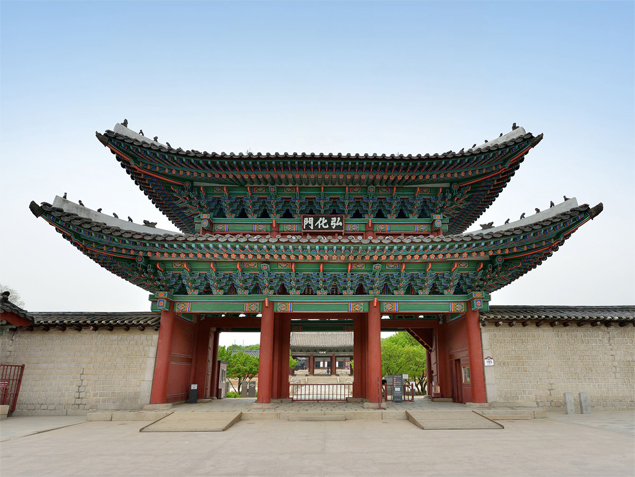
As a main gate of Changgyeonggung Palace, 'Honghwa(弘化)' literally means 'promoting harmony,' in other words, 'inspiring the public through exercise of virtue.' This gate was constructed at the same time when Changgyeonggung was established, destroyed during Imjinwaeran (Japanese Invasion of Joseon in 1592~1598), and rebuilt in 1616.
Honghwamun served as a platform where a king met the citizens. King Yeongjo (1694~1774, r. 1726~1774) collected public opinion in 1750 before enforcing Gyunyeok Act (Equalized Tax Act). In 1795, King Jeongjo (1752~1800, r. 1776~1800) handed rice out to the poors commemorating the 60th birthday of the Queen Mother Hyegyeonggung (1735~1815). This event is well depicted in the painting titled as Honghwamun Samido (Handing Rice Out at Honghwamun Gate).
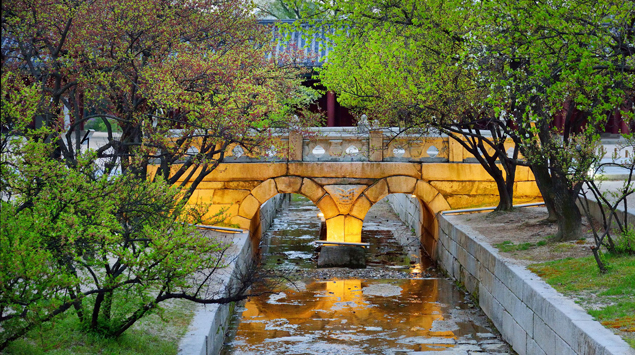
Built in 1484, Okcheongyo Bridge means 'a flowing river as pure as a jade marble.' In reality, clear water coming from Eungbongsan Mountain flows towards the south of Okcheongyo Bridge passing Jondeokjeong Pavilion of Changdeokgung Palace and Chundangji Pond of Changgyeonggung Palace. This bridge remains intact and designated as National Treasure No. 386. Under the arch of this bridge, goblin face is carved. This means protecting the palace against evil spirit coming through the river.
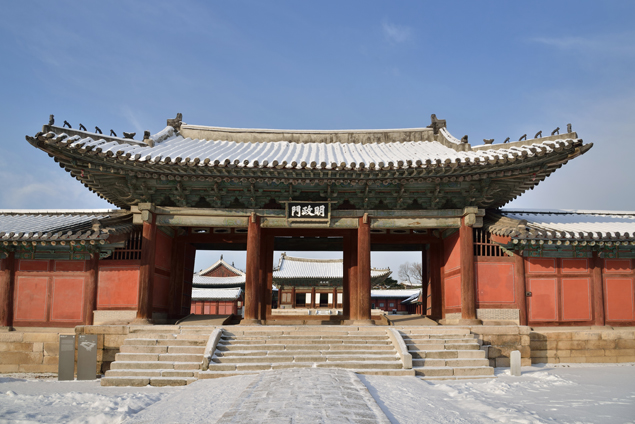
Facing Myeongjeonjeon Hall, this gate is situated in the center of the eastern wolang (the servants quarters on both sides of the gate). As the gate is located in the inner part of Honghwamun Gate, it serves as a middle gate having the form of pyeongsammun (a gate with three equal-height doors). The gate is not exactly on the west-east axis of Myengjeonjeon Hall but 1.2m away to the south, and accordingly, jungjeong (inner garden) has the shape of a slanted rectangle not a precise square. This building is a three-kan (one kan being a unit of measurement of the space between two columns) by two-kan structure with a column-top complex bracket system and a hip and gable roof. The building stands on a circular-shaped foundation stone and its each front kan has two wooden doors. According to its bracket system style and architectural structure, the gate appears to remain intact since it has been rebuilt during King Gwanghae (1575~1641, r. 1608~1623)'s reign.
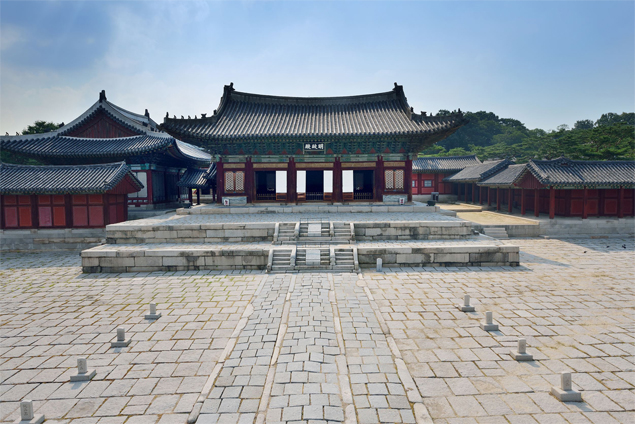
Myeongjeongjeon Hall is a jeongjeon (main hall) of the Changgyeonggung Palace where the official, royal rituals and events took place such as a king's enthronement, congratulatory ceremonies, state examinations, and royal receptions. For instance, King Injong (1515~1545, r. 1544~1545) ascended the throne at this hall and 66-year-old King Yeongjo (1694~1776, r. 1724~1776) and 15-year-old Queen Jeongsun (1745~1805)'s wedding ceremony was held here. Erected in 1484, destroyed during Imjinwaeran (Japanese invasion of Joseon in 1592~1598), and rebuilt in 1616, this building is considered the oldest jeongjeon of its kind, but relatively small in comparison to other two-story jeongjeons such as Geunjeongjeon Hall of Gyeongbokgung Palace or Injeongjeon Hall of Changdeokgung Palace. This is because Myeongjeongjeon Hall was initially built to be used as the queen's quarters, not for the king's official events.
The front garden displays a royal formality including wide, flat stone pavement and samdo (three passages) in the center. The two-rows of stones situated on the front garden are called pumgyeseok (a stone where an official rank is carved). During an official event, a government official stood next to each stone matching his rank. Accordingly, centering the middle passage for a king's walk referred to as eodo (king's passage), literary officials were placed on the right side of a king while military officials were positioned on his left.
Dapdo, a rectangle shaped stone located in the center of the stairs, refers to a stone above which a king's planquin was carried.
Inside of the building, yongsang (a king's seat) is located in the center and its behind, a folding screen featuring the Sun, Moon and Five Peaks is placed. The sun and moon refer to a king and queen or yang and yin each while the five peaks mean the Five-Elements or the whole nation. The painting implies the national prosperity and welfare of the people.
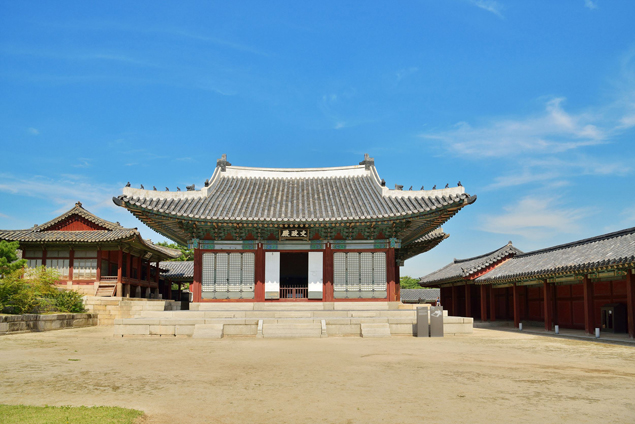
Munjeongjeon Hall is pyeonjeon (a king's office) where a king handled the work with his officials and made an important policy decision. The hall was rebuilt in 1616 after burned down during Imjinwaeran (Japanese invasion of Joseon in 1592~1598) but destroyed again during Japanese colonial period. Present building was reconsturcted in 1986.
This hall has also served as honjeon (a building where an ancestral tablet of a royal family was enshrined). Notably, the tablets for the deceased queen consorts of King Yeongjo (1752~1800, r. 1776~1800) and King Cheoljong (1831~1863, r. 1849~1863) had been kept here.
Munjeongjeon Hall is well known for the tragic history of Prince Sado (1735~1762), a son of King Yeongjo. Prince Sado was locked in a wooden chest and demoted to an ordinary citizen by his father King Yeongjo's command here at this hall. Prince Sado and the chest were later moved to a garden located inside of Seoninmun Gate. After 8 days of hunger and the heat, Prince Sado died in the chest.
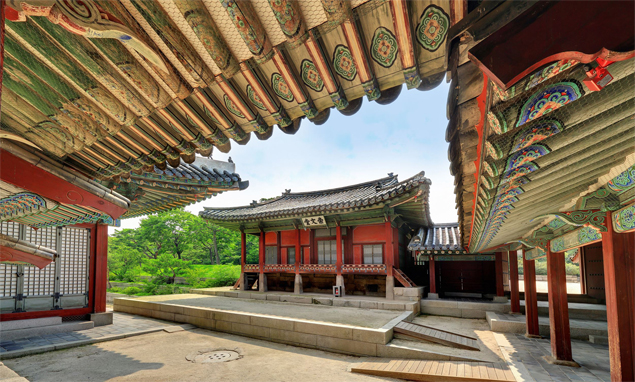
'Sungmun(崇文)' literally means 'revering a writing or literature.' This Sungmundang Hall was used as a king's study hall where the officials gave lectures on Confucian classics to the king. King Yeongjo (1752~1800, r. 1776~1800) had academic meetings and discussions with royal family members or students of Seonggyungwan National Academy. While exact year of its establishment is unknown, this building was rebuilt in 1834 after the fire in 1830. A signboard handwritten by King Yeongjo is hung on the inside wall. Extracted from Book of Odes (詩經), this text, Ilgamjaeja (日監在玆), demonstrates the importance of maintaining respectful attitude.
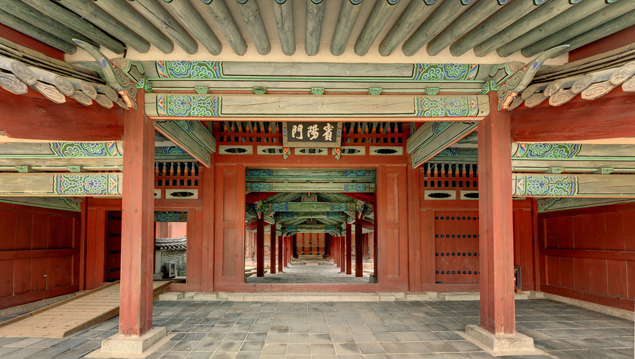
Located behind the Myeongjeongjeon Hall, Binyangmun Gate connects the king's official space and private quarters. 'Binyang' literally refers to 'respectfully greeting the brightness' and 'brightness' here also means 'yin', in other words, the king. As this gate served as an entrance door to the king's private sector, access through this gate was stirctly prohibited. Present building was reuilt in 1986 after its destroy during Japanese colonial period and later excavation in 1984.

Haminjeong Pavilion was built in 1633, destroyed due to fire in 1830, and rebuilt in 1834. Inyangjeon Pavilion was initially situated here in this site but destroyed during Imjinwaeran (Japanese invasion of Jorea in 1592~1598).
Haminjeong Pavilion was used as a king's study hall where the officials gave lectures on Confucian classics to the king. King Yeongjo (1752~1800, r. 1776~1800) greeted the successful candidates for state literary and military examinations here at this pavilion.
Present building has an open structure without the outer walls while Donggwoldo (The Eastern Palaces) painted in the 19th century depicts it as a pavilion with three-sided walls.
Hung on each four-sided inner walls, four signboards contain Chinese Gu Kaizhi (349?~410?)'s poem called Four Seasons and create a quaint beauty of the pavilion.
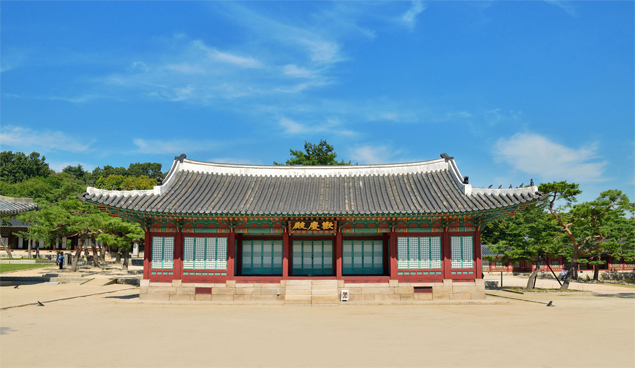
Hwangyeongjeon Hall was erected in 1484, destroyed due to fire during Imjinwaeran (Japanese invasion of Joseon in 1592~1598), rebuilt in 1616, burned down in 1830, and reconstructed in 1834.
This hall was mainly used as a a king or prince's living quarters. King Jungjong (1488~1544, r. 1506~1544) was born at this hall while Prince Sohyeon (1612~1645) passed away here. Historic records demonstrate this building has also served as honjeon (a building where an ancestral tablet of a royal family was enshrined) or binjeon (a building where a body or coffin of a decease royal family was kept).
Located in a secluded inner palace, Tongmyeongjeon Hall was mainly used as a queen's living quarters. This southern-facing building stood on gidan (a stone platform) and the beneath woldae (a large square podium mainly consturcted in front of an important building). Flat stones were paved on the outdoor garden where the royal rituals and events were held.
This place is renown for a bizzare story about Lady Jang (1688~1694, Jang Ok-jeong widely known as Jang Hee-bin). Lady Jang was a royal concubine and later became the queen consort of King Sukjong (1661~1720, r. 1674~1720). In 1694, when her predecessor Queen Inhyeon (1667~1701) returned to the palace and Lady Jang was demoted from the queen consort, Lady Jang attempted to curse Queen Inhyeon through making a shamanistic altar and burying hideous things. This caused Lady Jang's death and her body was moved to outside of the palace through Seoninmun Gate, the side door of the palace, not through the main Honghwamun Gate.
There is a spring behind the Tongmyeongjeon Hall. In 1757, King Yeongjo (1694~1774, r. 1726~1774) named it as 'yeolcheon (冽泉)' meaning 'fiery cold spring water.' A pond situated in the west of this hall was made in 1485 to prevent overflow of the pond.
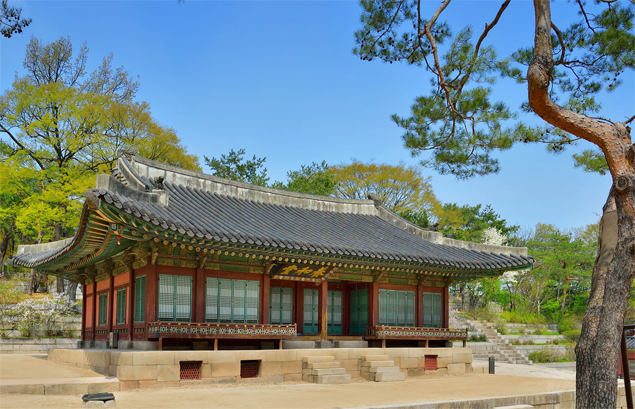
Yanghwadang Hall was mostly used as part of a king or queen's living quarters. As exceptions, King Injo (1595~1649, r. 1623~1649) stayed at this hall in a long term after Byeongjahoran (Qing invasion of Joseon in 1636) and held a reception for Qing envoys. The consort of King Cheoljong (1831~1863, r. 1849~1863) passed away here. Present building was rebuilt in 1834 after burned down in 1830.
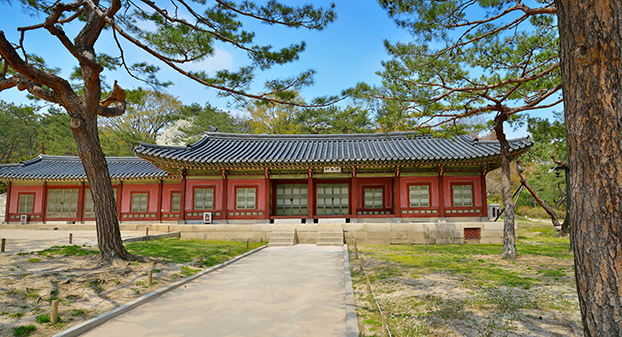
Facing sounthern side, Yeongchuneon House is a building mainly used for a queen's living quarters. Connected to Yeongchuneon, Jipbokeon House is a five-kan (one kan being a unit of measurement of the space between two columns) building located in the west of Yeongchuneon. While exact year of construction is unknown, these two Houses were destroyed by fire in 1830 and rebuilt in 1834. Beloved by King Jeongjo (1752~1800, r. 1776~1800), Yeongchuneon was used as his library and office. King Jeongjo was passed away at Yeongchuneon at his age of 49. Crown Prince Sado (1735~1762) and King Sunjo (1790~1834, r. 1800~1834) were born here at Jipbokeon.

Seated on a hill behind Yeongchuneon and Jipbokeon Houses, this Wind Streamer Pedestal is designed to hold the flag used to measure the direction and strength of wind. It appears to have been made together with Rain Gauge in 1770, installed inner side of Tongjemun Gate, and moved here before independece of the country. This pedestal is designated as National Treasure.
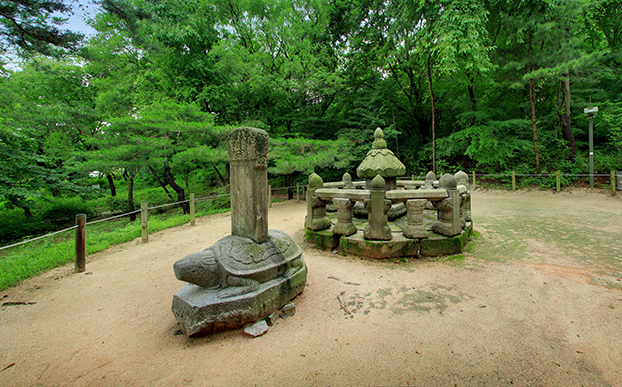
Placenta chamber refers to a special building or structure where a navel string of a newborn baby is placed. When a royal family was born in Joseon Dynasty (1392~1910), his or her navel string was kept in a speical jar and buried at a propitious place. This placenta chamber was made for King Seongjong (1457~1494, r. 1464~1494) and the stele contains history of construction and repair of the chamber. While the dispersed placenta chambers of Joseon royal families were moved to Seosamneung (Royal West Three Tombs) in Goyang-si, Gyeonggi-do during 1928 through 1930, the stone structure of King Seongjong's placenta chamber originally situated in Gwangju-si, Gyeonggi-do was placed here in 1928.
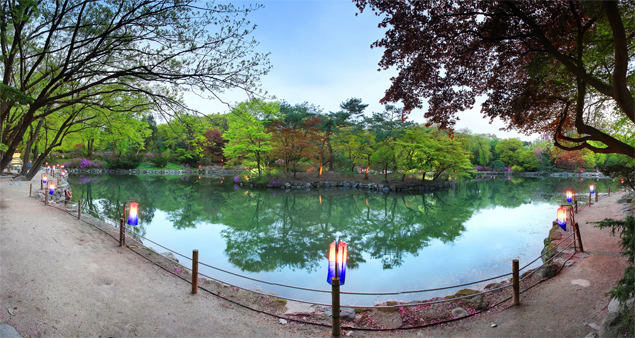
Chundangji Pond is comprised of two parts. Lower part was initially used as naenongpo (a farm where official enuchs cultivated vegetables to pay a tribute to the king). The king also held a ritual here in which he farmed himself. In 1909, the pond was made by Japanese and renovated in Korean traditional form in 1986. Small, upper part of the pond was the original location of this pond.
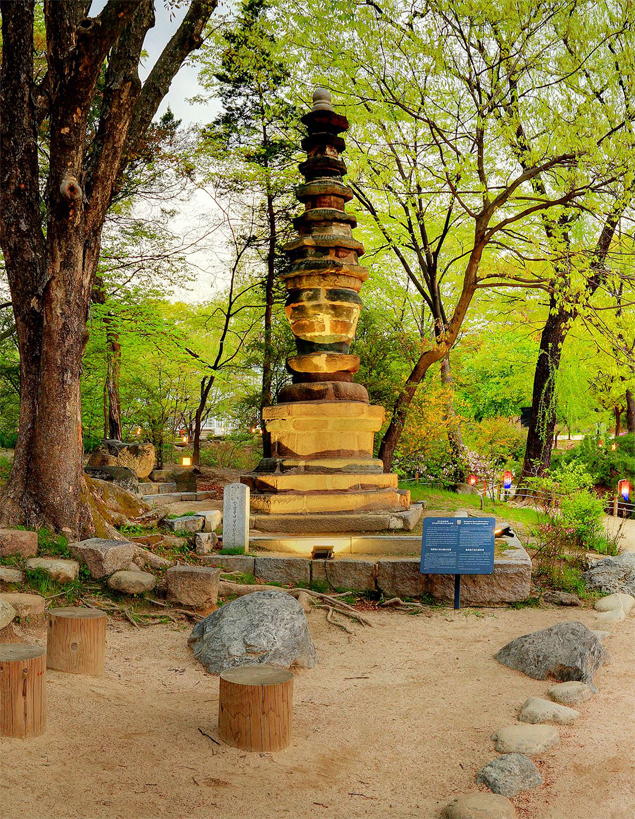
Standing at the side of Chundangji Pond, this Octagonal Seven-story Stone Pagoda is known to have been purchased from a merchant, who delivered the pagoda from Manchuria, and placed here at Changgyeonggung Palace when Yi-Royal Family Museum was established during Japanese colonial period. Founded on a square platform and double octagonal stone bases, this Tibetan style pagoda contains an inscription on its body recording that the pagoda was built in 1470 during Chinese Ming Dynasty.
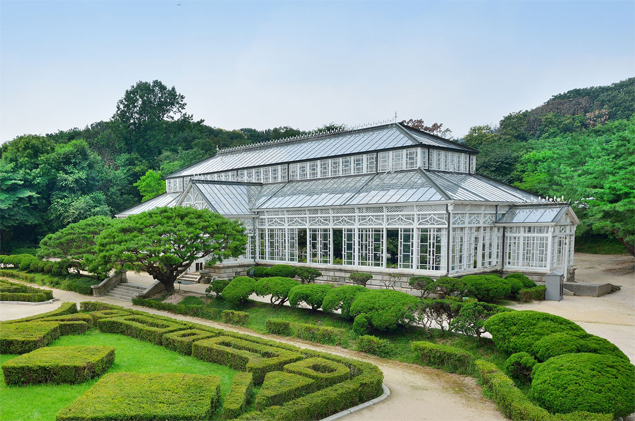
Established in 1909, this Grand Greenhouse is Korea's first western style greenhouse. This greenhouse was built together with a zoo inside of the Changgyeonggung Palace by Japanese colonial government under the pretext of consoling Emperor Sunjong (1874~1926, r. 1907~1910) who resided at Changdeokgung Palace, near Changgyeonggung, at the time. Designed by a Japanese designer and constructed by a French company, this western style building has mixed structures of steel frame and wood, and its exterior is covered in glass. When construction of the house was completed, rare plants such as ornamental plants from tropical areas were displayed. Korean native plants have been exhibited since the palace was restored in 1986. In 2004, the Grand Greenhouse was listed on the State-Registered Cultural Heritage No. 83.
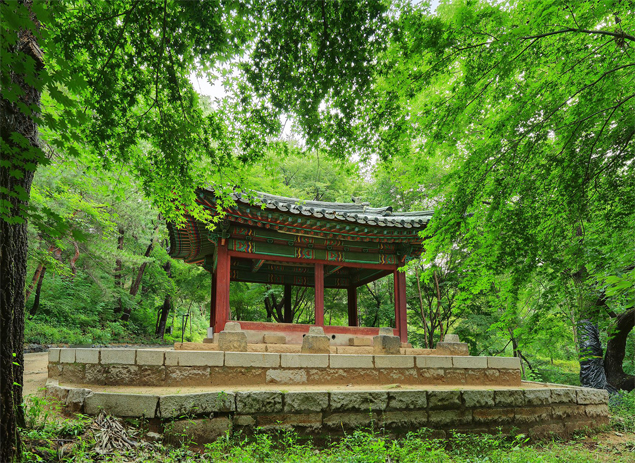
Located in the right side of Grand Green House, this place was initially used as silkworm farms. In 1624, Chimijeong Pavilion was built at this site and used as an archery field. The name of the pavilion was changed as Gwandeokjeong in 1664. There was a spacious filed around the pavilion where the soldiers practiced archery or horse riding.

Placed in front of Munjeongjeon Hall, this observatory appears to have been designed to observe celestial bodies through soganui (小簡儀 small simplified armillary sphere). According to Seoungwanji (書雲觀志, Book of Seoungwan or Astronomical Government Office), Gwancheondae (觀天臺, Celestial Body Observatory) was also referred to as Soganuidae(小簡儀臺, Small Simplified Armillary Sphere Observatory) given sogaui was installed on top of this facility. Recent studies suggest there was ilseongjeongsiui (日星定時儀, sun-and-stars time-determining instrument) installed at this facility. It was designated as Treasure in 1985.

Seoninmun Gate is linked to the south wall of Honghwamun Gate, in other words, the south-east wall of Changgyeonggung. It was established during King Seongjong (1457~1494, r. 1469~1494)'s reign, destroyed during Imjinwaeran (Japanese invasion of Joseon in 1592~1598), rebuilt during King Gwanghae (1575~1641, r. 1608~1623)'s reign, but destroyed again in 1857. Present building appears to have been reconstructed during King Gojong (1852~1919, r. 1863~1907)'s reign. Donggukyeojibigo (Note on the Eastern State) states that this gate was previously called Seolinmun and served as a main east gate through which the officials entered.
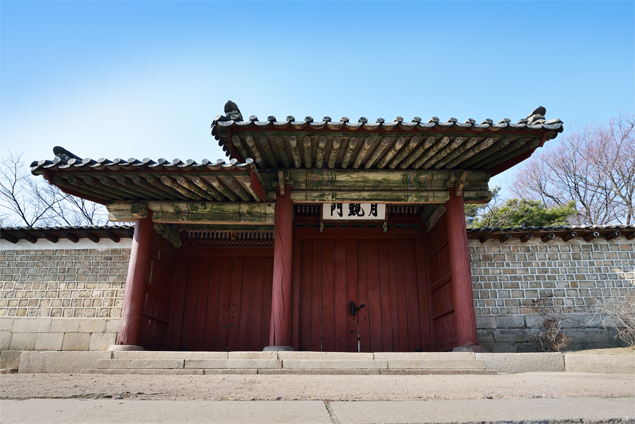
This gate was built in 1779 by King Jeongjo (1752~1800, r. 1776~1800) who wanted to have a direct access to Gyeongmogung Palace where his father - Prince Sado (1735~1762) - was buried. Its name, 'wolgeun (月覲),' literally means 'monthly diligence' and this was originated from the story that King Jeongjo used this gate everytime he paid his respect to his deceased father on the first day of each month.
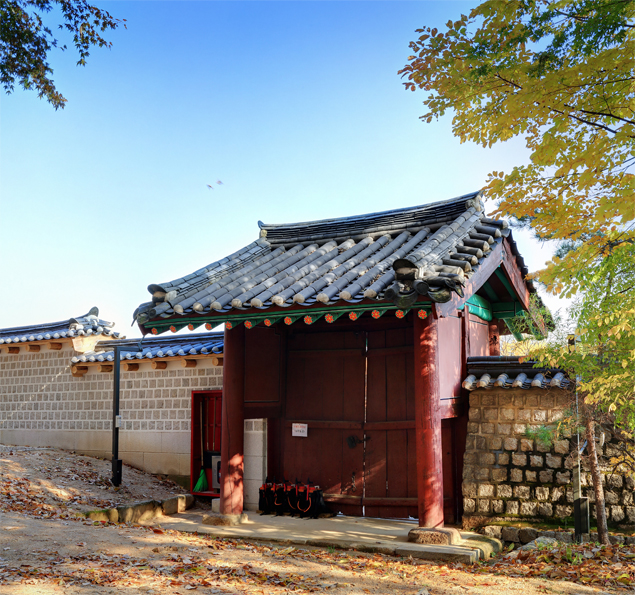
Located in the north-east wall of Changgyeonggung, Jipchunmun Gate is facing Munmyo Confucian Shrine of Seoul. This gate is not currently used for entry due to the private houses settled outside of the gate.
According to Donggukyeojibigo (Note on the Eastern State), this gate served as the east gate of Secret Garden and used for the king's access to Seonggyungwan National Academy. It appears to have been established during King Seongjong (1457~1494, r. 1469~1494)'s reign and present building was built at the end of Joseon Dynasty (1392~1910).



 >
>